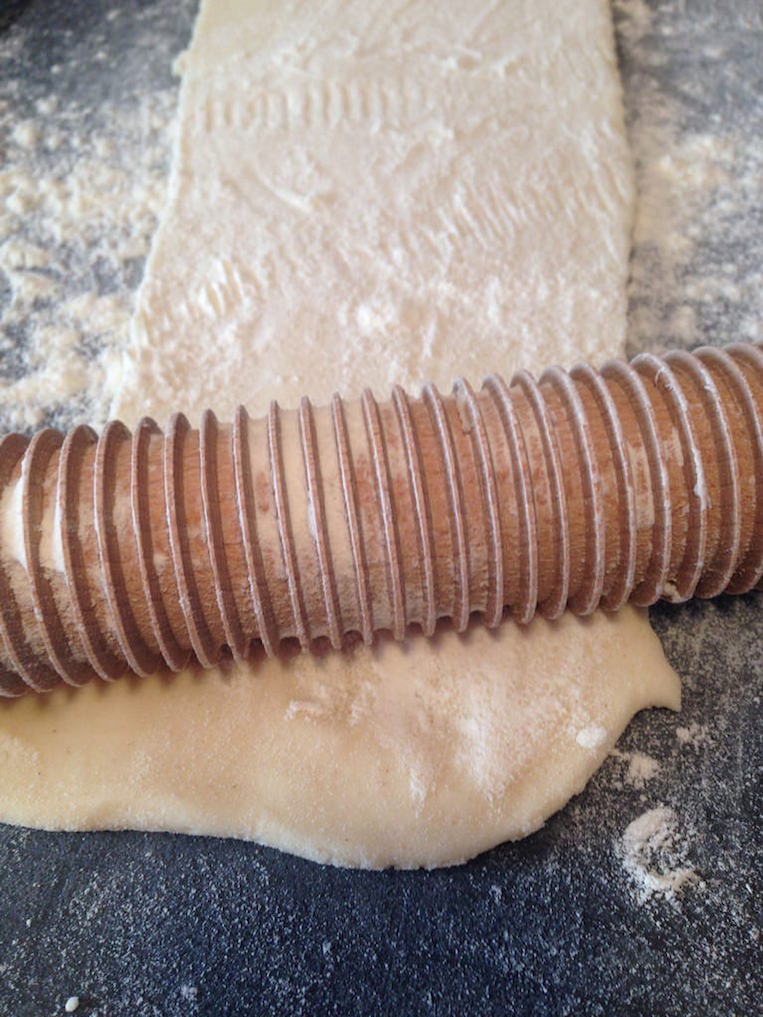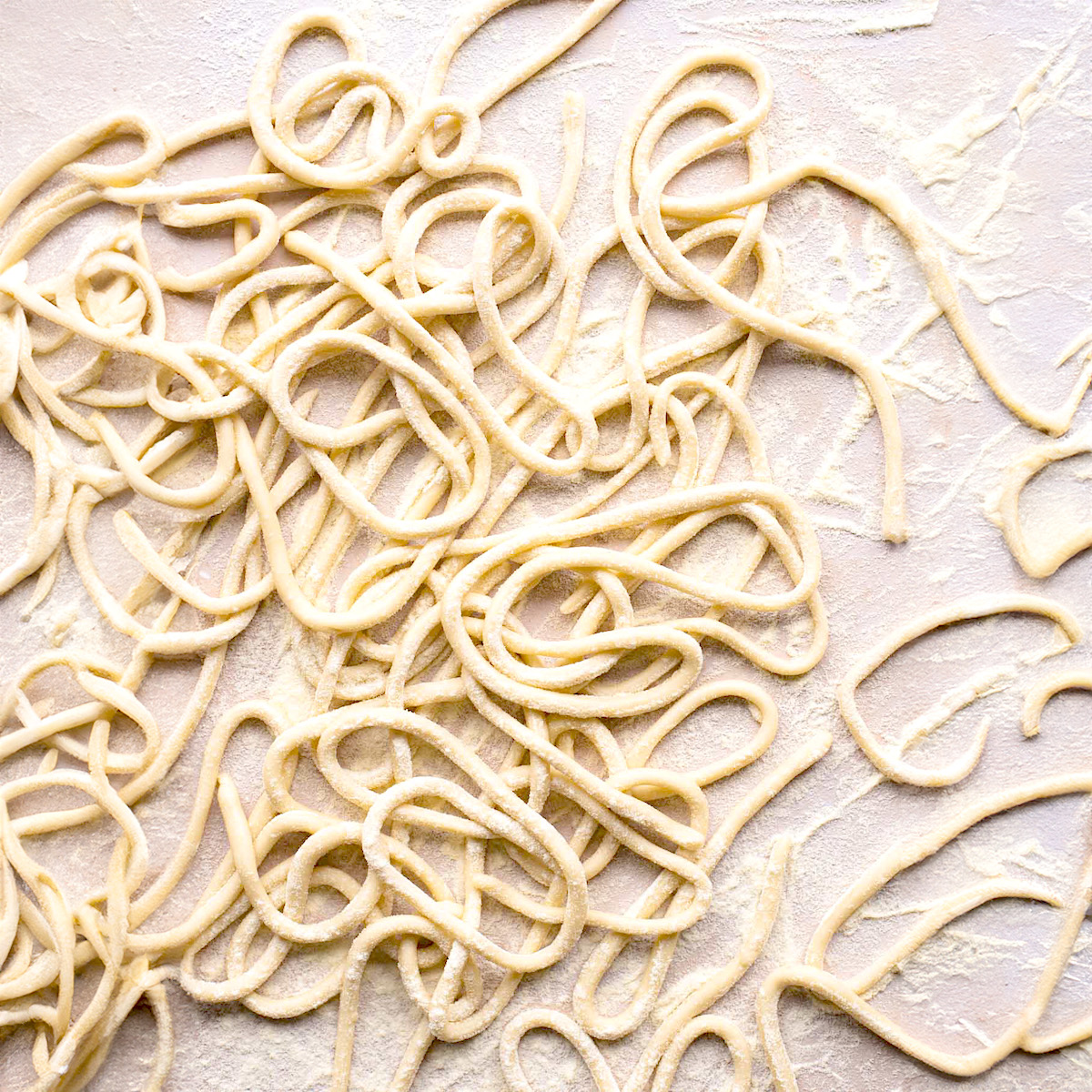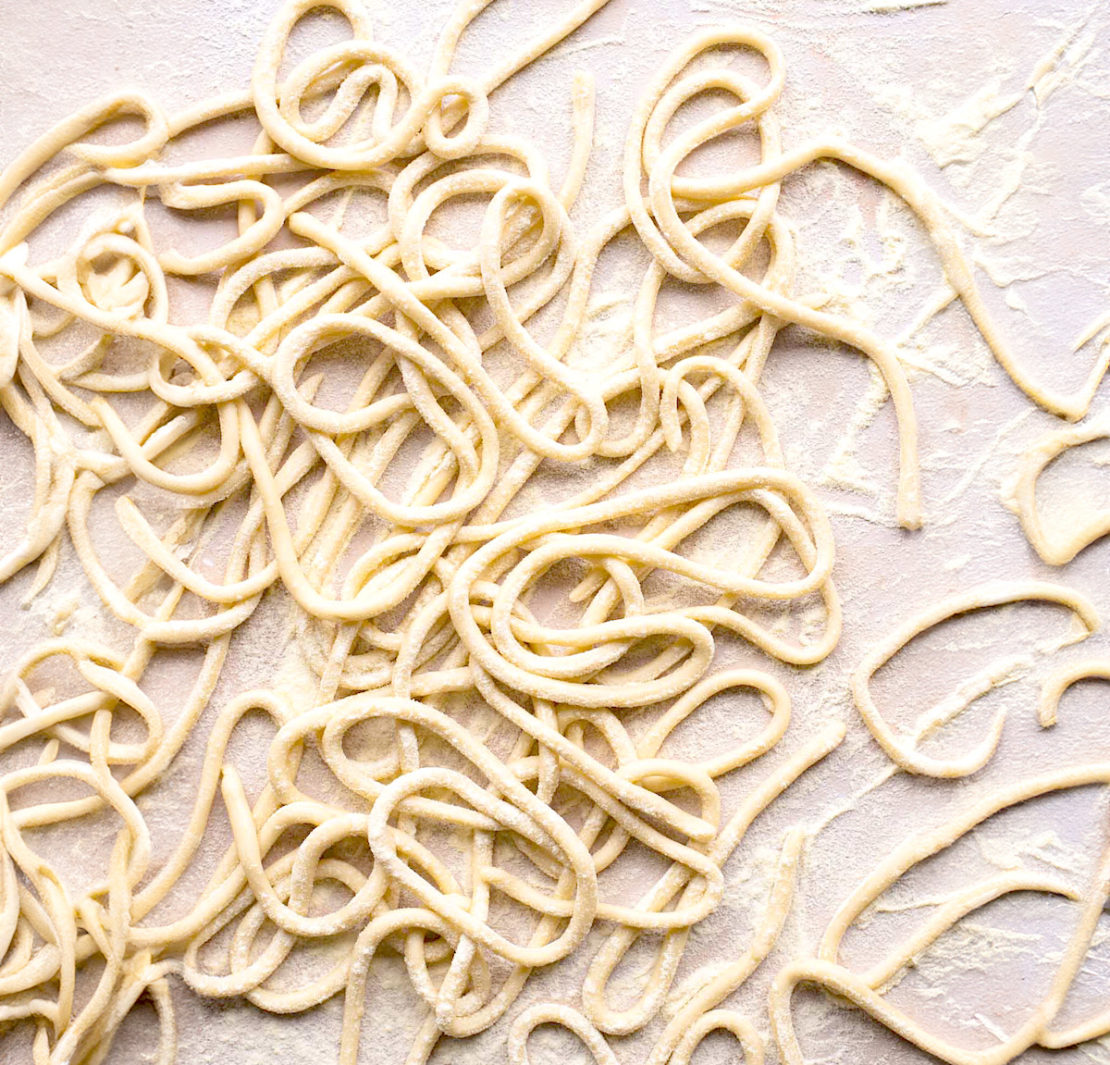Erika from CuocheinVacanza (www.cookingclassesintuscany.net), Tuscan DOC, is a Cooking Classes…
Pici, or “Fat Spaghetti,” is a a traditional Tuscan pasta that is easy to make. Only a handful of ingredients and steps are needed to make this wonderful dish. Here’s a step by step guide.
Pici is a thick, hand-rolled pasta, originating from the region of Tuscany, especially in the province of Siena. It’s sometimes described as “chunky spaghetti” due to its appearance. It has a slightly irregular, rough texture due to its handmade nature, which allows sauces to adhere to it beautifully. Pici is typically made using only durum wheat flour and water, without any eggs, though many variations – like mine – include a touch of olive oil. This makes it a vegan-friendly pasta option.
RECIPE NOTES
- Kneading: Proper kneading is essential for the dough’s texture. If the dough feels too sticky, add a bit more flour. If it’s too dry, add a splash of water.
- Resting Time: Don’t skip the resting period for the dough. This allows the gluten to relax, making it easier to roll out and shape.
- Thickness: The thickness of the pici is up to personal preference. Some like it thicker for a more rustic feel, while others prefer it slightly thinner.
- Cooking Time: Fresh pasta cooks much quicker than dried store-bought pasta. Keep a close eye on the pici when boiling to ensure they don’t overcook. They’re typically ready once they float to the water’s surface.
- Storing: If you’re not cooking the pici immediately, you can lay them out on a tray dusted with semolina and let them air dry for several hours. Once dried, they can be stored in an airtight container for a few days.
- Freezing: Pici pasta can be frozen for future use. To freeze, place the shaped pasta on a tray, ensuring they’re not touching. Freeze for a few hours, then transfer to a freezer bag. This method prevents them from sticking together.
- Sauce Pairings: Pici pasta is versatile and pairs well with various sauces. In Tuscany, a common pairing is “agli e olio” (garlic and oil) or a simple tomato sauce. However, the pasta’s robust texture also stands up well to heartier meat sauces.

Step by Step Guide to Making Tuscan Pici Pasta
Making the Pici Pasta Dough
- In a large mixing bowl, add the all-purpose flour and create a well in the center.
- Gradually pour in the water into the well, starting to incorporate the flour by using circular motions with your fingers or a fork. This will ensure the flour and water combine smoothly.
- Once the flour and water are mostly combined, add the olive oil and a pinch of salt to the mixture.
- Begin to knead the mixture in the bowl, combining all the ingredients thoroughly until you obtain a consistent mass.
- Continue kneading the dough on a flat surface for about 5 minutes. Your goal is to form a smooth, round, leaf-like shape with the dough.
- Once kneaded, cover the dough with either a cotton cloth or plastic wrap. Allow it to rest for approximately 30 minutes. This resting period will make the dough more pliable and easier to roll out.
Rolling and Shaping the Pici
- After allowing the dough to rest, flatten it gently with your hand. Then, using a rolling pin, roll out the dough until it’s about 1/4 inch thick.
- For shaping the pici, you have two methods:
- Traditional Method: Using a sharp knife, slice the rolled out pasta into 1/4 inch wide lengths. Don’t be overly concerned if some strips end up slightly longer than others, as homemade pasta often varies in size. Once sliced, take each strip and roll it on your work surface using the palms of your hands, giving them a rounded, spaghetti-like shape.
- Rolling Pin with Grooves Method: If you have a rolling pin with grooves, press it onto the rolled-out pasta while rolling. This will create evenly spaced grooves on the pasta. After you’ve rolled over the entire surface, pick out the individual strips, separating your thick spaghetti one by one. You can keep the shape as is or gently roll them with your hands for a more rounded appearance.
- Ensure your work surface is well-dusted with semolina flour. This prevents sticking. Once the pici are shaped, give them another light dusting of semolina to prevent them from sticking together.
Cooking the Pici Pasta
- Bring a large pot of water to boil. Once boiling, add about 2 teaspoons of salt.
- Carefully add the prepared pici to the boiling water. Allow them to cook for approximately 5 minutes, or until they rise to the surface and are al dente.
- Once cooked, drain the pici and toss them in your favorite sauce. Whether it’s a traditional ragu (meat sauce), pesto sauce, or pummarola (tomato sauce), they’ll be delicious. And don’t forget to top your dish with a generous sprinkle of Parmesan cheese for that authentic Italian touch!


Step by Step Guide to Making Tuscan Pici Pasta
5 Stars 4 Stars 3 Stars 2 Stars 1 Star
No reviews
- Author: Erika Elia
- Total Time: 50 minutes
- Yield: 1 pound of pasta 1x
Description
Pici, or “Fat Spaghetti,” is a a traditional Tuscan pasta that is easy to make, as it takes only a handful of ingredients and steps to make.
Ingredients
- 14 oz all purpose flour
- 4 oz semolina
- 7 fl oz (2/3 cup water)
- 2 tbsp Extra Virgin Olive Oil
- 1 pinch salt
Instructions
Making the Pici Pasta Dough
- In a large mixing bowl, add the all-purpose flour and create a well in the center.
- Gradually pour in the water into the well, starting to incorporate the flour by using circular motions with your fingers or a fork. This will ensure the flour and water combine smoothly.
- Once the flour and water are mostly combined, add the olive oil and a pinch of salt to the mixture.
- Begin to knead the mixture in the bowl, combining all the ingredients thoroughly until you obtain a consistent mass.
- Continue kneading the dough on a flat surface for about 5 minutes. Your goal is to form a smooth, round, leaf-like shape with the dough.
- Once kneaded, cover the dough with either a cotton cloth or plastic wrap. Allow it to rest for approximately 30 minutes. This resting period will make the dough more pliable and easier to roll out.
Rolling and Shaping the Pici
- After allowing the dough to rest, flatten it gently with your hand. Then, using a rolling pin, roll out the dough until it’s about 1/4 inch thick.
- For shaping the pici, you have two methods:
- Traditional Method: Using a sharp knife, slice the rolled out pasta into 1/4 inch wide lengths. Don’t be overly concerned if some strips end up slightly longer than others, as homemade pasta often varies in size. Once sliced, take each strip and roll it on your work surface using the palms of your hands, giving them a rounded, spaghetti-like shape.
- Rolling Pin with Grooves Method: If you have a rolling pin with grooves, press it onto the rolled-out pasta while rolling. This will create evenly spaced grooves on the pasta. After you’ve rolled over the entire surface, pick out the individual strips, separating your thick spaghetti one by one. You can keep the shape as is or gently roll them with your hands for a more rounded appearance.
- Ensure your work surface is well-dusted with semolina flour. This prevents sticking. Once the pici are shaped, give them another light dusting of semolina to prevent them from sticking together.
Cooking the Pici Pasta
- Bring a large pot of water to boil. Once boiling, add about 2 teaspoons of salt.
- Carefully add the prepared pici to the boiling water. Allow them to cook for approximately 5 minutes, or until they rise to the surface and are al dente.
- Once cooked, drain the pici and toss them in your favorite sauce. Whether it’s a traditional ragu (meat sauce), pesto sauce, or pummarola (tomato sauce), they’ll be delicious. And don’t forget to top your dish with a generous sprinkle of Parmesan cheese for that authentic Italian touch!
- Prep Time: 45 mins
- Cook Time: 5 mins
- Category: Primi
- Method: Rolling
- Cuisine: Italian
Erika from CuocheinVacanza (www.cookingclassesintuscany.net), Tuscan DOC, is a Cooking Classes Trainer and Private Dinners Chef who comes directly to your holiday home in Tuscany. Respect for Nature is her paramount, and is fundamental to Tuscan home cooking. Food Blogger and Trip Lover, she pays the utmost attention to the seasonality and authenticity of all the ingredients. If you're looking to take some of Tuscany home, what better way than to learn to cook your favorite dishes or have them cooked for you?



